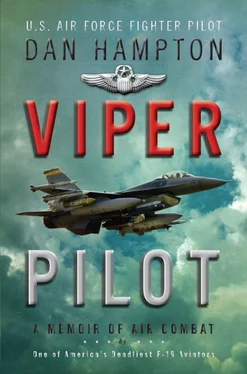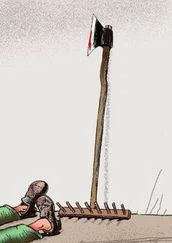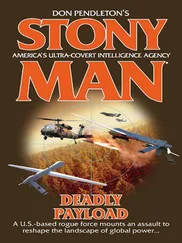I loved it. Whereas piloting the Tweet had been brute-force mastery over ugly machine, the T-38 called for finesse. It flew like a fighter (at least a 1970s-vintage fighter); the Air Force had several fighting versions in the form of the AT-38 and the F-5 Tiger II. It sat high above the ground and had the tremendous virtue of tandem seating. This was much better than the Tweet, where the instructor was sitting right next to you.
Jet flying clicked for me during the next six months. I’d come out of Tweets in the middle of the pack, but my hands and brain caught up with each other with the T-38. It had an afterburner, and we now wore G-suits to counter the effects of gravity during maneuvering. Compared to high-performance fighters, the T-38 wasn’t a tough nut to crack. But as I saw my reflection in the glass doors, with my G-suit and helmet, I thought I was already there—a fighter pilot on his way to deal death. Maybe it helped. Maybe not. But I liked the look.
About eleven months into the program, all the instructors and commanders went into a huddle over a long weekend. They examined everything about us; each test score, simulator flight, and actual flight had been graded and scored. This mass of sleepless nights and sweaty palms was compiled into an objective score. If there was a tie, then subjective aspects were called into play: attitude, aggressiveness, appearance, “military deportment,” etc.
After the instructors emerged from their powwow, the class survivors were now rank-ordered; in my class, from Number One to Number Twenty-two. A line was then drawn at the 20 percent mark, and everyone above the line was Fighter, Attack, Reconnaissance (FAR) qualified, while those below were going to Tankers, Transports, or Bombers (TTB). In my class, there were five of us above the line—the Air Force rounded up or down, depending on their requirements.
Through a combination of Boolean equations, black magic, and an honest attempt to predict operational needs, a small number of each type of aircraft would be apportioned to each graduating class. We were handed three fighters, so the top three names got them. The two poor bastards who were above the FAR line, but not in the top three, got to stay behind and become FAIPs. Every pilot had filled out a “dream sheet” with his top choices of aircraft and location. So the rankings and student preferences were matched up with the types of aircraft the Air Force had dealt out for that assignment cycle. The results were revealed during Drop Night.
This rite of passage took place on a Friday evening at the Officers Club. It was the first order of business for the night—before the effects of an open bar, music, and female groupies could take hold. The new pilot’s name was called, and, in conjunction with some properly embellished tales from his training, a picture of his next aircraft was shown on the screen. Sometimes, as a spirit-crushing joke, another plane would be flashed just to see the reaction. I mean, if you’re expecting a fighter, you’d slit your own throat if you thought you were getting a lumbering C-130 or a trainer. Remember, this night was the culmination of lifelong dreams, four years of college and a year of UPT. They put up a T-38 for me initially, and as my soul fled my body in shame, I remember actually grabbing the chair so I wouldn’t stagger. But amid the guffawing, hoots, and screams, there appeared a picture of a beautiful F-16. In the end, with lots of backslapping, each dazed pilot would walk to the front, shake hands, and receive his official orders. You got what you earned—I had a great night.
I left Vance after that year, considerably skinnier but with silver wings on my chest. As with most military programs, you soon realize that you actually haven’t finished anything, because there’s always the next course or school to attend. Everything you complete just opens a new door. For an aspiring fighter pilot, there was another full year of various training programs before you got to your first operational squadron.
First came the three-month Lead-In Fighter Training (LIFT) course at Holloman AFB, New Mexico. This was conducted in AT-38 aircraft, and the instructors were all fighter pilots. Actually, the real point of this course, and what made it great, was to teach the young punk how to be a fighter pilot. So, besides the obvious flying stuff like dropping bombs, strafing, and dogfighting, they taught other essentials—drinking games at the bar, hymns like “Sammy Small” and “Dear Mom, Your Son Is Dead.” We were stripped of all Air Training Command patches and issued Tactical Air Command (TAC) name tags and patches. It was a true mark of distinction to walk into any Officer’s Club bar wearing a TAC shield and a squadron patch with the initials TFS—Tactical Fighter Squadron.
We also went through centrifuge training here. Think of the little seat that got spun around the room at 400 miles per hour during The Right Stuff or Spies Like Us, and you’ve got the picture. See, we were really part of the first generation of fighter pilots going into high-G aircraft, and no one was certain about the long-term effects. When blood drains from the head during high-G forces, the brain goes to sleep. Obviously, in a jet fighter traveling at 900 feet per second, this is a bad thing, and too many pilots were getting killed. Where planes like the T-38 and older fighters could instantly pull, say, seven Gs, the engine and airframe couldn’t hold it very long. The Gs would “bleed off” to a very manageable four or five Gs. The danger in the F-16 was that it could sustain eight or nine Gs long past the point that the pilot could remain conscious. So the physiology folks, flight surgeons, and paper-pushers all had their panties in a wad over this, and the centrifuge training was supposed to acclimate a pilot to the sensations of high, sustained G forces. That means they strapped you in the seat and spun you till you passed out. Guys like me didn’t care. What’s one more risk in a profession built on them?
Actually, the biggest threats at LIFT were the “Holloman widows.” These gals, usually divorced from enlisted men, had been left there when their ex-husbands moved on. They were determined to do it right the second time around and marry an officer. Think of slightly older women from An Officer and a Gentleman, maybe with a kid or two, and you’ve got it. Since I couldn’t spell matrimony and had absolutely no desire for a wife and instant family, I avoided them like the plague.
After a year at Vance, Holloman was paradise. Well, Alamogordo, New Mexico, is hardly a metropolis, but, unlike Enid, it did not boast of eighty Baptist churches, nor did it have blue laws, and it did have the Sangre de Cristo Mountains. Albuquerque was only a few hours away, and there was moderately good skiing in Ruidoso. It was positively cosmopolitan after Oklahoma.
Following LIFT, I was sent to Advanced Survival training at Fairchild Air Force Base in Washington State. In February. Part of the course included an escape-and-evasion situation, where you are plopped down on a mountaintop with only the survival equipment you’d have after an ejection. This is to say, not much.
After being given a suitable head start—about an hour—you were pursued by armed soldiers whose sole excitement in life was chasing officers through the wilderness. In those days, the Soviet Union and Eastern Bloc countries were the big enemies, so that’s who these guys simulated. They only spoke Russian or German. Their uniforms, weapons, and attitudes were authentic. I think they all studied method acting in East Berlin.
I figured that trying to escape and evade in the snow, without snowshoes, while being chased by deranged sadists who intimately knew the terrain, just wasn’t going to work. It was, as we say, a nonstarter.
Читать дальше












